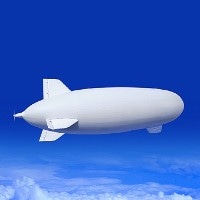Aug 5 2019
Reintroducing airships into the global transportation mix could help reduce the transport sector’s carbon emissions and play a role in forming a sustainable hydrogen-based economy. According to the researchers of an IIASA-led study, these lighter-than-air aircraft could eventually boost the feasibility of a 100% sustainable world.
 (Image credit: © Ssuaphoto | Dreamstime.com)
(Image credit: © Ssuaphoto | Dreamstime.com)
Airships were launched in the first half of the 20th century before conventional aircraft were used for the long-range transport of passengers and cargo. Their use in cargo and passenger conveyance was however rapidly discontinued for several reasons, including the danger of a hydrogen explosion—for which the Hindenburg disaster of 1937 served as a striking case in point; their lower speed compared to that of airplanes; and the lack of dependable weather forecasts.
Since then, significant advances in material sciences, man’s ability to predict the weather, and the pressing need to lower energy consumption and CO2 emissions, have progressively been bringing airships back into business, political, and scientific conversations as a potential transportation alternative.
The transport industry is accountable for about 25% of worldwide CO2 emissions caused by humans. Of these emissions, 3% emanates from cargo ships, but this figure is projected to increase by between 50% and 250% until 2050. These projections require finding new methods to conveying cargo with lower CO2 emissions and a lower demand for energy.
In their paper published in the Springer journal Energy Conversion and Management, scientists from IIASA, Brazil, Germany, and Malaysia investigated how an airship-based industry could be created using the jet stream as the energy medium to transport cargo worldwide.
The jet stream is a core of robust winds that flows from west to east, about 8 to 12 km above the Earth’s surface. According to the scientists, airships flying in the jet stream could lower fuel consumption and CO2 emissions, as the jet stream itself would add most of the energy necessary to move the airship between destinations, resulting in a round trip of 16 days in the northern hemisphere, and 14 days in the southern hemisphere. This is significantly less time compared to existing maritime shipping routes, especially in the southern hemisphere.
The scientists hypothesize that the reintroduction of airships into the transport industry could also provide an alternative for hydrogen transportation. Hydrogen is a good energy carrier and a beneficial energy storage alternative. Given that renewable electricity, for instance, extra wind power, can be turned into hydrogen, there is positivity that the hydrogen economy will become a core part of a clean and sustainable future.
One of the hurdles to executing a hydrogen-based economy is cooling the hydrogen to below -253 °C in order to liquefy it. The process uses up nearly 30% of the embodied energy, with additional energy of about 3% necessary to carry the liquefied hydrogen.
In their study, the researchers, however, suggest that rather than using energy in liquefaction, hydrogen in gaseous form could be carried within the airship or balloon and conveyed by the jet stream with a lower fuel demand.
Once the airship or balloon gets to its destination, the cargo can be delivered removing around 60% or 80% of the hydrogen used for lift, and leaving 40% or 20%, of the hydrogen inside the balloon or airship to offer sufficient buoyancy for the return trip without cargo.
To resolve the danger of hydrogen combustion in the airship, the team proposes automating the operation, loading, and unloading of hydrogen airships and developing flightpaths that avoid cities to minimize the danger of fatalities in the event of an accident.
According to research lead-author Julian Hunt, an IIASA post-doctoral fellow, a more interesting aspect revealed in this study is the likelihood that airships and balloons can also be used to enhance the effectiveness of liquefying hydrogen.
As the stratosphere’s temperature (where the airships will be flying to use the jet stream) differs between -50 °C and -80 °C, it means that less energy will be needed to match the -253 °C mark if the process occurs onboard the airship. The energy needed for the extra cooling required can be produced using the hydrogen in the airship.
Hunt says that this process also presents several supplementary possibilities: The process of producing energy from hydrogen creates water—one ton of hydrogen creates nine tons of water. This water could be used to raise the airship’s weight and save more energy in its descending trajectory.
Another probable application for the water generated is rainmaking, which involves discharging the water formed from the stratosphere at a height where it will freeze before entering the troposphere where it will melt again. This lowers the temperature and raises the relative humidity of the troposphere until it saturates and begins to rain. The rain will then trigger a convection rain pattern, thereby feeding even more humidity and rain into the system. This process could be used to lessen water stress in regions experiencing shortages.
Airships have been used in the past and provided great services to society. Due to current needs, airships should be reconsidered and returned to the skies. Our paper presents results and arguments in favor of this. The development of an airship industry will reduce the costs of fast delivery cargo shipping, particularly in regions far from the coast.
Julian Hunt, Study Lead-Author and Post-Doctoral Fellow, IIASA
Hunt continued, “The possibility to transport hydrogen without the need to liquefy it would reduce the costs for the development of a sustainable and hydrogen-based economy, ultimately increasing the feasibility of a 100% renewable world.”